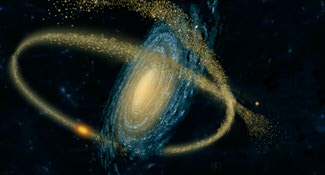Galaxy Structure, Formation and Evolution
The Kapteyn Institute has always been deeply involved in the study of galaxies, starting with Jacobus Kapteyn himself, in studying the Milky Way. The study of galaxy formation and evolution still constitutes one of the core research themes at the Institute today.

Key questions
How did galaxies form and how did they evolve into their current state? When we look at very distant galaxies, we are actually looking back in time. This allows us to probe samples of galaxies from the moment when they were born until today. On the other hand, by inspecting the current, local universe (the Milky Way, the Local Group) in full detail, we can also recover the fossils from the evolutionary history.
Observations from the rotation of stars and gas in galaxies, from the motion of galaxies in clusters and from the universe as a whole, all indicate that a significant fraction, 90%, of the mass of the Universe must be in a non-radiating form. This so-called dark matter is believed to be in the form of particles yet to be discovered on Earth.
Some of the key questions driving galaxy structure, formation, and evolution research include:
-
How do galaxies form during the earliest phases of the Universe?
-
How do galaxies evolve over cosmic time and form the range of galaxy types currently observed?
-
What is the role of dark matter and (HI) gas in the formation of galaxies?

Projects
Some of the projects, programmes, and instruments in galaxy research in which the institute is involved:
-
The study of high-z galaxies with the JWST, HST, VLT, ALMA, and other world-class facilities
-
The study of the dynamics of our MW and other galaxies with,e.g., Gaia, WEAVE
-
The Fornax Deep Survey
-
The XSL stellar library
-
The study of weak and strong gravitational lensing with e.g. VST-KiDS, HST, Keck, ALMA and Euclid
-
The study of HI in galaxies with, e.g., APERTIF, MeerKAT, SKA
-
Milky Way foreground studies with LOFAR

Future research
The future of galaxy evolution research at the Kapteyn Institute is based on the scientific exploitation of new facilities that are becoming available this decade, as well as capitalizing on current developments, such as the studies of the Epoch of Reionization with LOFAR and APERTIF HI studies.
Kapteyn astronomers are highly involved in JWST, particularly via the MIRI European Guaranteed Time, which will allow them to study galaxy evolution since very early cosmic times. These analyses will be complemented with larger-area galaxy studies with Euclid, which was launched in 2023.
In addition, further projects on the physics of galaxy formation from the Epoch of Reionization to the Local Universe will be conducted using ground-based facilities, such as WEAVE/WHT and different instruments (MICADO, MOSAIC) on the E-ELT.
Academic staff
Academic staff working in this field are: Caputi, Dayal, Helmi, van der Hulst, Fraternali, Koopmans, McKean, Oosterloo, Peletier, Rizzo, Starkenburg, Tolstoy, Trager, Valentijn, Verheijen, Wang, van de Weijgaert.
| Last modified: | 09 October 2024 10.05 a.m. |
